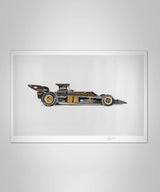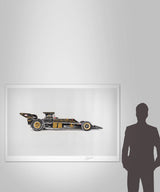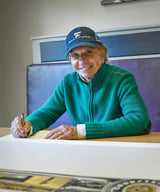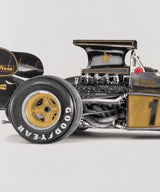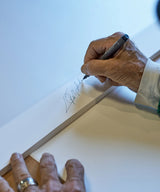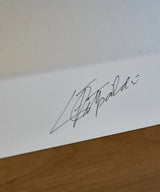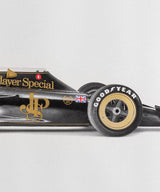50 years on from Emerson Fittipaldi's 1972 World Championship victory with Team Lotus, we were honoured and tremendously excited to be invited by Emerson Fittipaldi and Clive Chapman of Classic Team Lotus, to celebrate the car and the man, in a remarkable and beautiful collaboration with artist and photographer Alan Thornton. Alan has taken Classic Team Lotus's 72D into the studio and shot it beautifully at very high resolution on a large format camera. With his London based team using hand pulled screen printing, he has rendered the image onto St. Cuthbert's Somerset archival paper, made in England, at a very large size: 1.5 metres wide and 1 metre high. Alan has used spot colours to maximise the intensity of the image and has rendered the gold parts of the livery in genuine 23.75 Carat Gold Leaf. The result is an imposing and incredibly beautiful handmade print, that delivers in equal and generous measure, the technical and engineering virtuosity of this revolutionary car, and the glamour of a truly golden age in F1.
Emerson took time out ahead of a shoot with Sky at Brands Hatch recently to sign the prints, and we enjoyed his warmth, wit and engaging modesty for a couple of hours, exploring amongst other things his close relationship with Colin Chapman and his views on F1 today. Each print has been meticulously signed by him in archive quality ink.
- Hand-signed by 1972 and 1974 Formula 1 World Drivers' Champion Emerson Fittipaldi
- A special edition limited to just 50 prints
- 150cm wide by 100 cm tall
- Based on photographs taken of the real 1972-Championship winning car as it is today
- Hand-finished in 23.75ct gold leaf
- Fine art, hand-pulled silkscreen prints
- Utilises water-based inks, printed onto 400 gsm St. Cuthbert's Somerset archival paper, made in England
- Created by artist and photographer Alan Thornton
This fine art screen print is of the Lotus 72, raced by the Team Lotus in the FIA Formula 1 World Championship from 1970 to 1975, initially in the memorable red, white and gold of sponsor Gold Leaf and later in the iconic black and gold of John Player Special. Conceived by Colin Chapman and Maurice Philippe, the 72 is arguably the most significant and successful car designs in Formula 1 history, rewriting the rules of aerodynamic interpretation and influencing single-seater design to this very day. Mid-mounted radiators allowing Lotus founder Colin Chapman to create a more aerodynamic profile than anything which had come before. Tipping the scales at exactly 530kg, the very minimum allowed within the regulations, it was one of the lightest F1 cars ever. With a career spanning six seasons, the Type 72 made a remarkable one hundred forty-nine Grand Prix starts across 75 races, securing three Constructors' Championships in 1970, 1972 and 1973, and two Drivers' Championships in 1970 with Jochen Rindt and 1972 with Emerson Fittipaldi. The 72 earned 20 race wins and 19 further podiums in the hands of some of the finest drivers to have graced motorsport: Rindt, Fittipaldi, Reine Wisell, Ronnie Peterson and Jacky Ickx.
The Process
Screen printing is the process of transferring a stencilled artwork onto a flat surface using a mesh screen, ink and a squeegee. Starting with the photography, the subject matter is composed and lit with the intermediate processes and the final print in mind - each step very much influences the final outcome. In post-production the image is refined and manipulated to create the final tonal variations needed for the separation of colours, which are then half toned which simulates continuous-tone imagery through the use of dots or lines, varying either in size or in spacing, thus generating a gradient-like effect. For each colour, a positive acetate is transferred to a silk screen frame coated in photosensitive emulsion. Following exposure, washing out and drying, the frame is mounted on a to print bed, and the chosen colour ink is then forced through the mesh with a squeegee by hand. This is a highly skilled craft process, sensitive to the touch, feel and technique of the printer, and as a result each print is unique.








